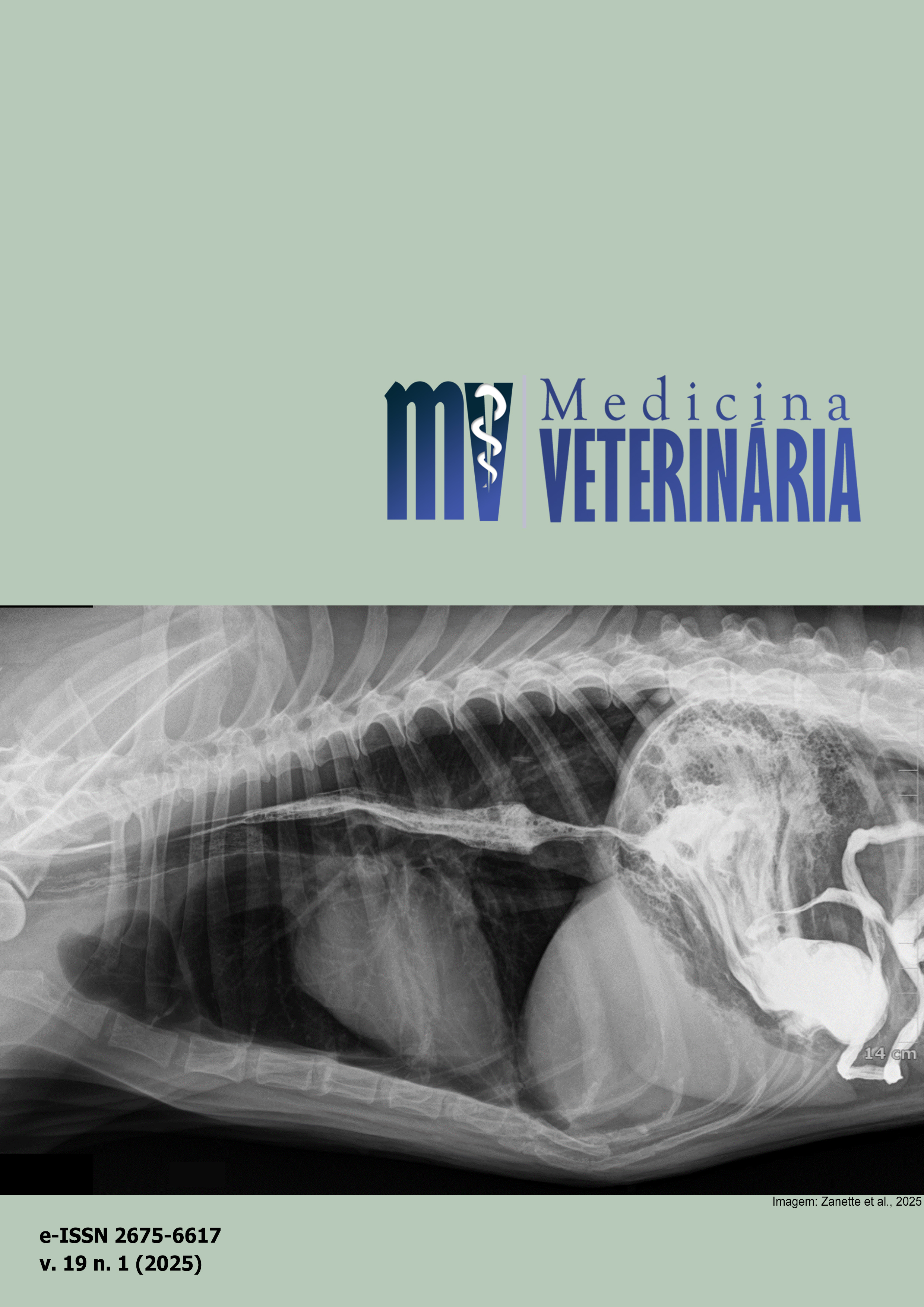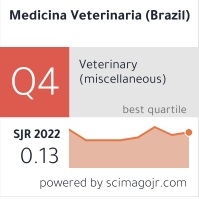Occurrence of gastrointestinal parasites in pig from non-technified productions in the Metropolitan Region of Curitiba, Brazil
DOI:
https://doi.org/10.26605/medvet-v19n1-6745Keywords:
Ascaris suum, coccidia, helminths, parasites, smallholdersAbstract
Among the causes of productivity losses in swine productivity, the presence of gastrointestinal parasites is noteworthy. In order to design an effective control program for this problem, information is needed on the occurrence of parasite species in the locations concerned. For this reason, the aim of this study was to evaluate the occurrence of gastrointestinal parasites of pigs in non-technified productions in the Metropolitan Region of Curitiba. Fecal samples from 280 pigs from 192 farms were analysed. For the analysis, the qualitative test of spontaneous sedimentation and the count of eggs per gram of feces in the McMaster chamber were performed. Furthermore, those responsible for the farms were asked about the use of anthelmintics and the cleaning and hygiene of the facilities. Overall, 91.1% of the samples tested were positive; the most common parasite forms were strongyle eggs (66.8%), followed by Ascaris suum eggs (47.1%) and coccidia oocysts (46.1%); Balantidium coli cysts (16.8%), Trichuris suis eggs (7.1%) and Strongyloides sp. eggs (1.1%) were also present. The average total number of eggs, oocysts, or cysts per gram of feces was 1009.2±1078.8 with a range from 25 to 12,175. Regarding the questions asked to breeders, 93.2% said they provided antiparasitic to the pigs, 44.8% removed waste daily and only 13.3% said they washed and disinfected the facilities. It is concluded that the occurrence of gastrointestinal parasites is high in pigs from farms in the metropolitan region of Curitiba and that both helminths and protozoa affect these animals.Downloads
References
Barbosa, A.S.; Bastos, O.M.P.; Dib, L.V.; et al. Gastrointestinal parasites of swine raised in different management systemsin the State of Rio de Janeiro, Brazil. Pesquisa Veterinária Brasileira, 35(12): 941- 946, 2015.
Bawm, S.; Chel, H.M.; Khaing, Y.; et al. The strong influence of management factors on coccidian infections in smallholder pig farms and the first molecular identification of Cystoisospora suis in Myanmar. Parasite, 29(1): 1-11, 2022.
Brito, G.G.; Santos, T.B.; Melo, C.M.; et al. Ocorrência de enteroparasitas em amostras fecais de suínos do município de Simão Dias – SE. Cadernos de Graduação - Ciências Biológicas e da Saúde, 1(15): 11-18, 2012.
COMEC. Coordenação da Região Metropolitana de Curitiba. A Região Metropolitana de Curitiba. Disponível em: https://www.comec.pr.gov.br/Pagina/Regiao- Metropolitana-de-Curitiba. Acesso em: 31 nov. 2022.
Dey, T.R.; Dey, A.R.; Begum, N.; et al. Prevalence of end parasites of pig at Mymensingh, Bangladesh. Journal of Agriculture and Veterinary Science, 7(4): 31–38, 2014. Gordon, H.M; Whitlock, H.V.A. New techinique for counting nematode egg in sheep faeces. Commonwealth Science and Industrial Research Organisation, 12: 50-52, 1939.
Hoffman, W.A.; Pons, J.A.; Janer, J.L. The sedimentation-concentration method in Schistosomiasis mansoni. Journal of Public Health and Tropical Medicine, 9: 283-291, 1934.
IBGE. Instituto Brasileiro de Geografia e Estatística. Clima. 2002. Disponível em: http://geoftp.ibge.gov.br/informacoes_ambientais/climatologia/mapas/brasil/Map_BR_cli ma_2002.pdf. Acesso em: 31 dez. 2022. Instituto Brasileiro de Geografia e Estatística - IBGE. Censo Agro 2017. 2018. https://censos.ibge.gov.br/agro/2017/. Acesso em: 15/07/2021.
Junhui, D.; Teng, Y.M.; Guangen, M. The prevalence of common intestinal parasites in domestic pigs in Shaanxi province of China. Advances in Food Science and Technology, 5(10): 1-6, 2017.
Katakam, K.K.; Thamsborg, S.M.; Dalsgaard, A.; et al. Environmental contamination and transmission of Ascaris suum in Danish55 organic pig farms. Parasites & Vectors, 9(80): 1-12, 2016.
Kochanowski, M.; Karamon, J.; D?browska, J.; et al. Occurrence of Intestinal Parasites in Pigs in Poland - the Influence of Factors Related to the Production System. Journal of Veterinary Research, 61(4): 459–466, 2017.
Kouam, M.K.; Ngueguim, F.D.; Kantzoura, V. Internal Parasites of Pigs and Worm Control Practices in Bamboutos, Western Highlands of Cameroon. Journal of Parasitology Research, 2018: 1-10, 2018.
Kumsa, B.; Kifle, E. Internal parasites and health management of pigs in Burayu District, Oromia Regional State, Ethiopia. Journal of the South African Veterinary Association, 85(1): 1-5, 2014.
Lutz, A. O Schistosomum mansoni e a schistosomatose, segundo observações feitas no Brasil. Memórias do Instituto Oswaldo Cruz, 11: 121-155, 1919.
Nwafor, I.C.; Roberts, H.; Fourie, P. Prevalence of gastrointestinal helminths and parasites in smallholder pigs reared in the central Free State Province. Onderstepoort Journal of Veterinary Research, 86(1): 1-8, 2019.
Ózsvári, L. Production impact of parasitisms and coccidiosis in swine. Journal of Dairy, Veterinary & Animal Research, 7(5): 217-222, 2018.
Pradella, B.; Molosse, K.F.; Menin, M.; et al. (2020). Occurrence of gastrointestinal parasitic diseases of swine in different production phases in commercial pig farms from the State of Santa Catarina, southern Brazil. Arquivo Brasileiro de Medicina Veterinária e Zootecnia, 72(5): 1683-1690, 2020.
Roesel, K. et al. Prevalence and risk factors for gastrointestinal parasites in small-scale pig enterprises in Central and Eastern Uganda. Parasitology Research, 116(1): 335–345, 2017.
Santos, C.L.A. et al. Suinocultura agroecológica e industrial: nutrição, sistemas de produção e sanidade. Informativo Técnico do Semiárido, 10(2): 31-36, 2016.
Santos, J.J.F.; Sousa, V.F.O.; Ribeiro, M.D.S.; et al. Suinocultura de subsistência como alternativa de geração de renda no sertão paraibano: um estudo de caso. Revista Desafios, 7(4): 96-105, 2020.
Sharma, D.; Singh, N.K.; Singh, H.; et al. Copro-prevalence and Risk Factor Assessment of Gastrointestinal Parasitism in Indian Domestic Pigs. Helminthologia, 57(1): 28–36, 2020.
Silva filha, O.L.; Pimenta Filho, E.C.; Souza, J.F.; et al. Caracterização do sistema de produção de suínos locais na microrregião do Curimataú Paraibano. Revista Brasileira de Saúde e Produção Animal, 9(1): 07-17, 2008.
Silva, C.R.E.; Macêdo, E.S.; Brandão, E.M.; et al. Avaliação parasitária de suínos nativos da região da baixada maranhense. Archives of Veterinary Science, 20(2): 58-66, 2015.
Statistix. Statistix 10 analytical software. Tallahassee, FL, USA. 2013. Disponível em: https://www.statistix.com Symeonidou, I. et al. Prevalence and Risk Factors of Intestinal Parasite Infections in Greek Swine Farrow-To-Finish Farms. Pathogens, 9(7): 1-14, 2020.
Taylor, M.A.; Coop, R.L.; Wall, R.L. Parasitologia veterinária. 4ª ed. Rio de Janeiro: Guanabara Koogan, 2017. 1052p.
Zdybel, J. et al. Effectiveness of selected stages of wastewater treatment in elimination of eggs of intestinal parasites. Journal of Veterinary Research, 59: 51–57, 2015.
Downloads
Published
How to Cite
Issue
Section
License
Copyright (c) 2025 Darleny Eliane Garcia Horwat, Marília Cristina Pinto, Paula Teixeira Poltronieri, Juliana Sperotto Brum

This work is licensed under a Creative Commons Attribution-NonCommercial-ShareAlike 4.0 International License.
A Revista de Medicina Veterinária permite que o autor retenha os direitos de publicação sem restrições, utilizando para tal a licença Creative Commons CC BY-NC-SA 4.0.
De acordo com os termos seguintes:
Atribuição — Você deve dar o crédito apropriado, prover um link para a licença e indicar se mudanças foram feitas. Você deve fazê-lo em qualquer circunstância razoável, mas de nenhuma maneira que sugira que o licenciante apoia você ou o seu uso.
NãoComercial — Você não pode usar o material para fins comerciais.
CompartilhaIgual — Se você remixar, transformar, ou criar a partir do material, tem de distribuir as suas contribuições sob a mesma licença que o original.
Sem restrições adicionais — Você não pode aplicar termos jurídicos ou medidas de caráter tecnológico que restrinjam legalmente outros de fazerem algo que a licença permita.







